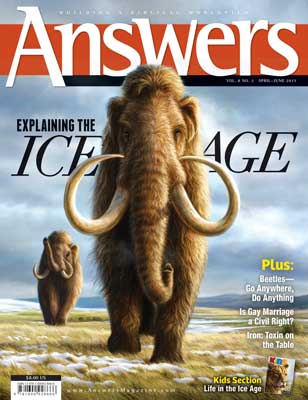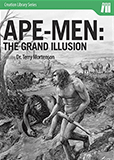Answers Research Journal
Answers Research Journal was started in 2008 to glorify the Creator by evaluating scientific findings in light of Scripture. The goal is to bring together some of the finest minds in creation research to provide the best possible insights into God’s work since Creation Week.
ARJ stands apart as a top-quality, free online journal, which can quickly distribute new findings in creation research, including unlimited space for graphics and color images.
Below is a taste of the newest insights you can gain from ARJ at AnswersResearchJournal.org.
Amphibian Created Kinds
Creationists are in the process of refining the list of creatures that most likely represent the original kinds of animals that God created during Creation Week.
One of the researchers working for the future Ark Encounter (ArkEncounter.org), Tom Hennigan, has examined taxonomic and hybridization data on the more than 7000 species of amphibians living today. Focusing on two amphibian orders, Caudata (salamanders) and Gymnophiona (caecilians or worm-like amphibians), Hennigan estimates that there were 53 salamander kinds and one caecilian kind on the Ark.
Hennigan describes these kinds and gives insights into how similar animals, such as the Japanese and Chinese giant salamanders, are determined to belong to the same kind.
Future papers will address the living anuran kinds (frogs and toads) and the living sauropsids, which include lizards, tuataras, crocodiles, snakes, and turtles. The ultimate goal is to determine a precise total of individual amphibians and reptiles that could have been on the Ark.
See “An Initial Estimate Toward Identifying and Numbering Amphibian Kinds within the Orders Caudata and Gymnophiona” by Tom Hennigan.
Human-Chimp DNA Similarity
A common evolutionary claim is that the DNA of chimpanzees and humans are nearly identical, up to 99% the same. However, this oversimplified claim is now becoming much less popular among primate evolutionists in light of modern DNA research.
Jeffrey P. Tomkins, of the Institute for Creation Research, analyzes recent comparisons of the human and chimp genomes that indicate a much lower degree of similarity than previously thought. Tomkins shows how earlier studies arrived at artificially high degrees of similarity by selective comparison of genes and by assuming that much DNA that did not match was simply “junk,” left over from the evolutionary past.
By downloading and querying 40,000 chimp DNA sequences against four different versions of the human genome assembly, Tomkins calculated that only 69 percent of the chimpanzee X chromosome was similar to human DNA, and genome-wide, only 70% of the chimpanzee DNA was similar to human DNA. He concludes that overall, the extreme discontinuity between the two genomes defies standard evolutionary presuppositions about a common ancestor.
See “Comprehensive Analysis of Chimpanzee and Human Chromosomes Reveals Average DNA Similarity of 70%” by Jeffrey P. Tomkins.
Abraham’s Place in History
For many years, most secular scholars assumed that the person the Bible calls Abraham lived at the same time as Hammurabi, king of Babylon, but many lines of evidence indicate that he lived much earlier. Indeed, it’s more likely that Moses, who lived many centuries after Abraham, was Hammurabi’s contemporary.
Matt McClellan argues from Genesis and archaeological evidence that Abraham must have lived much earlier than Hammurabi, during a period secular scholars call the early Bronze Age. This is the period when cities were first being founded, rather than later times when cities like Ur and then Babylon dominated other cities in the region.
The destruction of Sodom and Gomorrah occurred during the Early Bronze Age, according to Dr. Bryant Wood of the Associates for Biblical Research. So that would mean Abraham grew up even earlier, during a time known as the Early Dynastic period.
Young-earth creationists recognize that the standard dates for the ancient Middle East are inflated, but this research helps us recognize that post-Flood civilizations were undergoing massive changes during the brief lifetime of a single individual.
See “Abraham and the Chronology of Ancient Mesopotamia” by Matt McClellan.
Answers Magazine
April – June 2013
What unique conditions were required to start the Ice Age, and where does it fit in Bible times? Why did Ice Age animals grow so big, and what happened to them? Also, can you explain why God made more species of beetles than any other animal? Can you prove that Genesis 1–3 is not a Near Eastern myth? Read the answers to these questions and many, many more in this issue!
Browse IssueRecommended Resources

Answers in Genesis is an apologetics ministry, dedicated to helping Christians defend their faith and proclaim the good news of Jesus Christ.
- Customer Service 800.778.3390
- Available Monday–Friday | 9 AM–5 PM ET
- © 2025 Answers in Genesis




